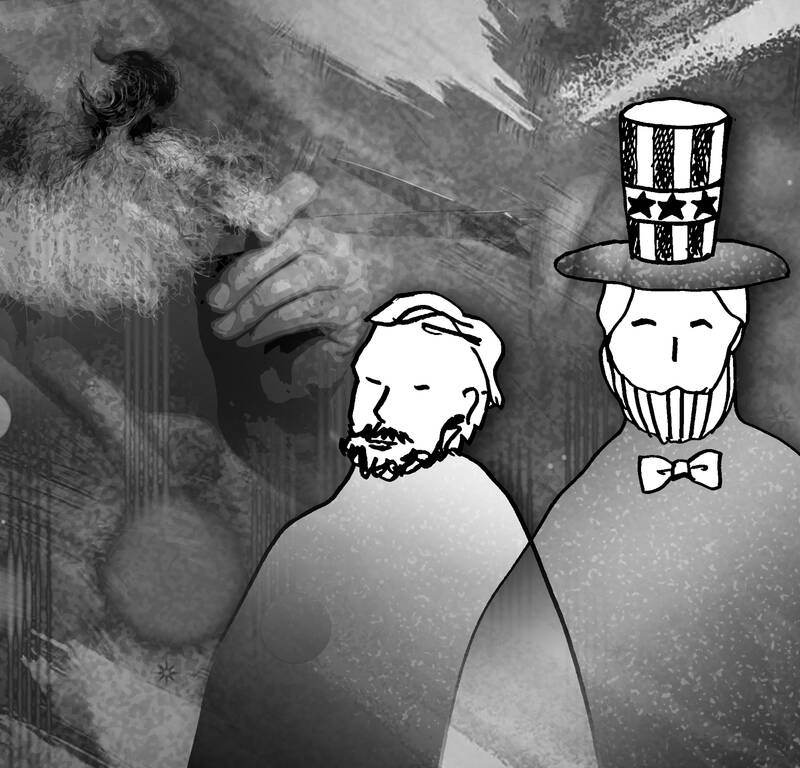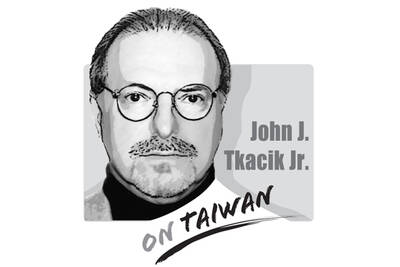The Earth did not exactly shake when the New York Yankees announced last week that they would allow their players to wear beards. However, the change in the half-century-old policy could stand as a symbol of our cultural epoch. That is because, for the first time in more than a century, beards are coming to be seen as markers of the ruling class.
No, seriously.
And not just because when US Vice President JD Vance took the oath, he became the first bearded vice president since 1909. The beard, which in my lifetime has been treated as synonymous with oddball, has become a thing again. Even Prince William has joined the bewhiskered. Some fear that the revival represents nostalgia for a lost masculine ideal, or maybe, as Yankees managing general partner Hal Steinbrenner said, it is just that the current generation believes their facial hair is part of their individuality.

Illustration: Tania Chou
Either way, if one walks, say, the streets of Midtown Manhattan, one spies the clan of the bearded streaming in and out of the office towers — a sight that, just a generation ago, would have been unthinkable.
Indeed, for much of late modern history, the barbigerous were regarded with skepticism. During the 19th century, the European monarchies associated beards with dangerous radicals. So did the dangerous radicals. Historians tell us that philosophers Karl Marx and Friedrich Engels grew their famously fulsome facial hair, at least in part to symbolize their rejection of middle-class morality.
In the US, a beard was often seen as a symbol of the abolitionist movement. Abolitionist John Brown sported one. So did John C. Fremont, the anti-slavery Republican who lost the 1856 presidential election. Former US president Abraham Lincoln did not grow his beard until after he was elected in 1860, but it was in full bloom by the time he took the oath of office — more evidence, for Southerners, of the threat he posed to their way of life. However, once the 16th president took the oath, the fashion gathered steam among the nation’s leaders until, in writer Gore Vidal’s words, “all sorts of odd excrescences had begun to blossom on political faces.” Republican newspapers ran advertisements for potions that would help ambitious males cover those bare chins. Even editorial writers got into the act, praising the “magical influences” of those who wanted “beards or whiskers.” Soon, the Victorians made beards safe to wear, even for the elites. Doctors wrote learned essays insisting that beards were good for male health.
In the early 20th century, the culture moved the other way. Suddenly, beards were bad again. Many writers attribute the shift to the rise of the safety razor, which was patented in 1904. However, historian Christopher Oldstone-Moore in his 2017 volume Of Beards and Men: The Revealing History of Facial Hair said that the commonly told story confuses cause and effect: The new invention caught on, because the popularity of whiskers was already fading. Oldstone-Moore linked the decline of the beard to the rise of urbanism and corporatism. The cleanly shaved face became a device through which men could “display the virtues of a new century: youthfulness, energy, cleanliness and reliability.”
By 1976, when Yankees owner George Steinbrenner commanded that players henceforth be clean-shaven, the nation’s aversion to beards was complete. Once again, the bristly chin had come to symbolize radicalism, even membership in the fabled counterculture. Former Cuban president Fidel Castro had a beard. Marxist revolutionary Ernesto “Che” Guevara had a beard. A syndicated columnist who visited the East Village in lower Manhattan described it as a hangout for “misfit artists” and “bearded Negroes.”
When political activist Jerry Rubin wrote that Marx was “history’s most infamous, bearded, longhaired, hippie commie freek [sic] agitator,” the Yippie founder meant every word as complimentary. Historian Anthony Esler entitled his 1971 monograph on rebellious young people: Bombs, Beards, and Barricades. The few sports figures who sported beards — former basketball player Reggie Jackson to the fore — were seen as politically defiant and, therefore, problematic.
Worried employers adopted rules limiting male facial hair, and, back then, the courts largely acquiesced. The inability of the bearded to get jobs was mocked in popular music. Experts advised men in the job market to shave their faces.
In January 1985, with then-US president Ronald Reagan poised to begin his second term, the inaugural committee created a kerfuffle by advertising for “attractive, clean-cut, all-American types” to perform at the celebration. Critics insisted that the description was code for “white.” After singer Diana Ross canceled her scheduled performance, the committee backed down, explaining, in classic Washington-speak, that the ad had been placed without being checked by higher-ups, that there could not have been any discriminatory intention, because lots of minority performers had been hired, and that the phrase in question actually meant “pleasant” and “outgoing.”
However, the point was made. Beards were still out; and not only on Steinbrenner’s Yankees. During the hearings over Reagan’s 1987 effort to put then-US Court of Appeals judge Robert Bork on the US Supreme Court, then-US senator Howell Heflin asked the nominee to explain why he had a beard. (To be fair, Heflin concluded the colloquy with a perhaps overly honest apologia: “There’s nothing wrong with it, because there are a lot of bearded voters out there that I don’t want to make mad.”)
Which brings us to today. According to Oldstone-Moore, the man who proudly sported a beard in the late 19th century was “excited about its moral force, in particular its power to express masculine power and authority.” Since then, we have come full circle. A 2015 study found women were somewhat less likely to vote for male candidates with facial hair. On the basis of appearance alone, hirsute politicians were considered more masculine, but also less likely to hold “feminist” positions on issues ranging from abortion to sex discrimination.
Social scientists said there is a continuing bias against bearded applicants. When no-beard policies fall most heavily on Black and Hispanic men, they are often unlawful. Nevertheless, judicial sympathy for hirsute plaintiffs has been far from unlimited, and recent research suggested that bearded men still face headwinds in job-seeking. (Although not necessarily in all professions.)
Beards in the White House, beards in the Royal Family, beards on Wall Street, beards in tech and, yes, beards on the Yankees players (if a bit late). If I did not know better, I would think it was still the 1970s. However, it is not. Ours is, alas, a more masculine era, aggressive and angry. I hope the new affection for beards does not make things worse.
One last note: I do not think I have mentioned that I have worn a beard for decades. Maybe in college, I considered heavy facial hair a mark of the radical beliefs I used to profess, but nowadays, my small goatee carries no ideological significance. From time to time, I consider shaving my beard, but I forbear for the best and simplest reason of all: My wife likes how it looks.
Stephen L. Carter is a Bloomberg Opinion columnist, a professor of law at Yale University and author of Invisible: The Story of the Black Woman Lawyer Who Took Down America’s Most Powerful Mobster.
You wish every Taiwanese spoke English like I do. I was not born an anglophone, yet I am paid to write and speak in English. It is my working language and my primary idiom in private. I am more than bilingual: I think in English; it is my language now. Can you guess how many native English speakers I had as teachers in my entire life? Zero. I only lived in an English-speaking country, Australia, in my 30s, and it was because I was already fluent that I was able to live and pursue a career. English became my main language during adulthood

Somehow, US intelligence identified “the Houthis’ top missile guy” and pinpointed his exact location. At 1348 hours (Washington time), March 15, President Trump’s national security advisor Mike Waltz texted, “positive ID of him walking into his girlfriend’s building.” The unsuspecting Romeo entered. High above, the drone monitoring the building registered a flash. When the smoke cleared, Mr. Waltz texted, “…And it’s now collapsed.” RIP. The star-crossed “top missile guy” had been target number one in the now uproarious US Navy bombing campaign on that Sunday against the Yemeni rebels who have been holding the Red Sea hostage since October 19,
Taiwan on Monday celebrated Freedom of Speech Day. The commemoration is not an international day, and was first established in Tainan by President William Lai (賴清德) in 2012, when he was mayor of that city. The day was elevated to a national holiday in 2016 by then-president Tsai Ing-wen (蔡英文). Lai chose April 7, because it marks the anniversary of the death of democracy advocate Deng Nan-jung (鄭南榕), who started Freedom Era Weekly to promote freedom of expression. Thirty-six years ago, a warrant for Deng’s arrest had been issued after he refused to appear in court to answer charges of
The Opinion page has published several articles and editorials over the past few weeks addressing Taiwan’s efforts to leverage unique or strong aspects of its culture to increase international awareness of the nation. These have included submissions by foreign journalists and overseas students, highlighting how bubble milk tea, Guinness World Record attempts, the entertainment sectors, impressive scenery, world-class cuisine and important contributions to the high-tech supply chain can enhance Taiwan’s recognition overseas and therefore its soft power. That entails competing for attention in already crowded sectors. Other nations, after all, offer popular entertainment exports, beautiful scenic spots and great food.